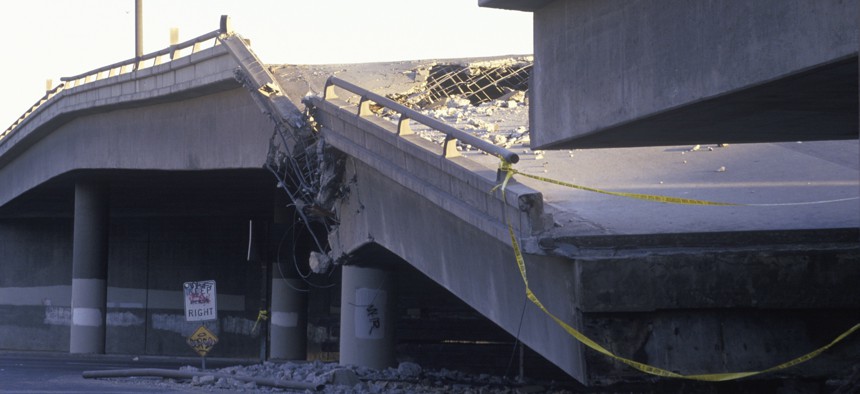USGS Grant to Fund Earthquake Early Warning System Expansion on West Coast

A section of Interstate 10 in Los Angeles collapsed during the 1994 Northridge earthquake. Joseph Sohm / Shutterstock.com
Four universities in California, Oregon and Washington state will get much needed money to improve ShakeAlert technology that’s been under development.
The United States Geological Survey announced on Thursday that it’s awarding $4 million to four West Coast universities for continued development of the ShakeAlert earthquake early warning system.
While such a system can’t predict when a major seismic event is going to start, once a quake is detected, a system like ShakeAlert can send a warning faster than certain seismic waves can travel, giving local authorities, transportation agencies, utilities, hospitals, schools, businesses and other entities farther away from the epicenter precious seconds to take cover, and, if possible, secure vulnerable infrastructure.
While earthquake early warning systems have been in place in Japan and Mexico for many years, the United States has lagged in developing such a system for the seismically vulnerable West Coast. But small-scale prototypes have been tested in California and Washington state.
In the case of a major earthquake originating on the far southern section of the San Andreas Fault in California, authorities in Los Angeles would have more than a minute of advance warning before seismic waves would hit the city. That would allow L.A. Metro trains to come to a stop, fire departments to open their garage doors, hospitals to halt surgeries and schools to get students under sturdy furniture.
Major cities like Seattle and Portland, Oregon, could get a similar amount of lead time in the event of the next Cascadia megathrust earthquake that is expected to bring a catastrophic level of destruction to the Pacific Northwest.
Real-life tests of ShakeAlert have been successful in recent seismic events. During a 6.0 magnitude earthquake in Napa County, California, in August 2014, a lab at the University of California at Berkeley received an alert about 10 seconds before the seismic waves reached the campus , roughly 40 miles from the epicenter.
In February, a magnitude 4.3 earthquake in Washington state’s Cascade Range tested the Pacific Northwest Seismic Network based at the University of Washington with mixed results. The warning was 18 seconds slow because of a lack of enough seismic sensors in the vicinity of the epicenter, which delayed the alert being relayed to partners testing the system.
But it’s expected that more funding for the expansion of early warning systems will increase the effectiveness. Down the road, quake alerts could also be relayed via smartphone apps , expanding the reach of the technology to the average consumer.
The $4 million grant to expand and improve ShakeAlert will go to UC-Berkeley, the California Institute of Technology, the University of Washington and the University of Oregon.
According to the USGS announcement :
Under the new cooperative agreements, the USGS and its four university partners will collaborate to improve the ShakeAlert EEW system across the west coast of the United States, and will continue to coordinate across regional centers in southern California, northern California, and the Pacific Northwest. The USGS and its university partners will continue development of scientific algorithms to rapidly detect potentially damaging earthquakes, more thoroughly test the system, and improve its performance. In addition, they will upgrade and construct approximately 150 seismic sensors to improve the speed and reliability of the warnings. They will also develop user training and education, and add additional test users. There are currently 70 organizations that are test users, from sectors such as utilities and transportation, emergency management, state and city governments, and industry.
As The Seattle Times reported Thursday, a fully-functioning earthquake early warning system for the West Coast would cost about $16.5 million annually , which would fund a staff of 50 people and improved seismic sensors across California, Oregon and Washington state.
(Photo by Joseph Sohm / Shutterstock.com )
Michael Grass is Executive Editor of Government Executive’s Route Fifty.
NEXT STORY: How States Can Make Their Digital Offerings Accessible to People With Disabilities






